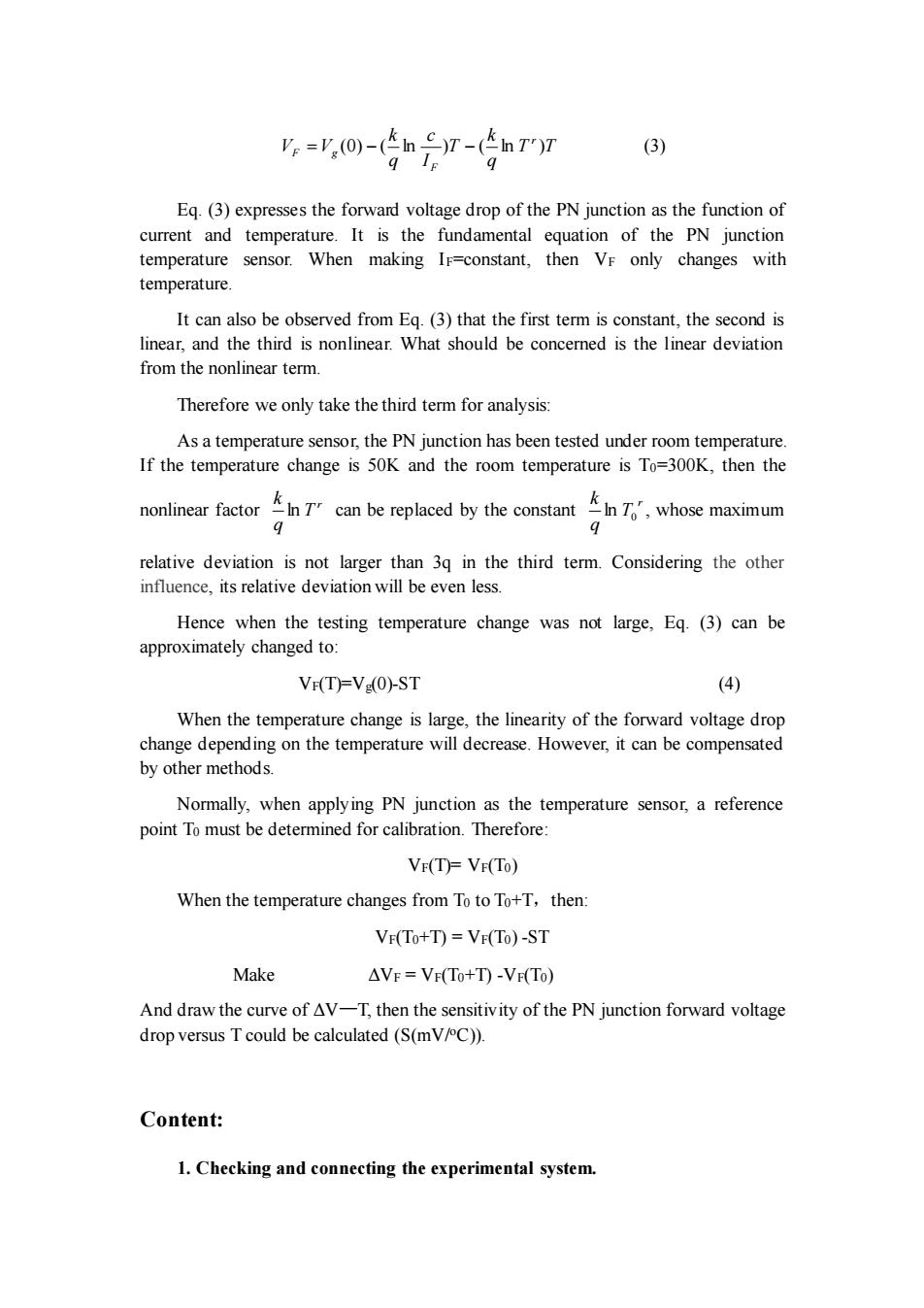正在加载图片...

V,=yeo)-(色nSr-(hTrT (3) Eq.(3)expresses the forward voltage drop of the PN junction as the function of current and temperature.It is the fundamental equation of the PN junction temperature sensor.When making IF=constant,then Vr only changes with temperature. It can also be observed from Eq.(3)that the first term is constant,the second is linear,and the third is nonlinear.What should be concerned is the linear deviation from the nonlinear term. Therefore we only take the third term for analysis: As a temperature sensor,the PN junction has been tested under room temperature. If the temperature change is 50K and the room temperature is To=300K,then the nonlinear factorcan be replaced by the constantwhose maximum relative deviation is not larger than 3q in the third term.Considering the other influence,its relative deviation will be even less. Hence when the testing temperature change was not large,Eq.(3)can be approximately changed to: VF(T)=Vg(0)-ST (4) When the temperature change is large,the linearity of the forward voltage drop change depending on the temperature will decrease.However,it can be compensated by other methods. Normally,when applying PN junction as the temperature sensor,a reference point To must be determined for calibration.Therefore: VF(T)=VF(To) When the temperature changes from Toto To+T,then: VF(To+T)=VF(To)-ST Make △VF=Vr(To+T)-Vr(To) And draw the curve of AV-T,then the sensitivity of the PN junction forward voltage drop versus T could be calculated (S(mV/C)). Content: 1.Checking and connecting the experimental system.T T q k T I c q k V V r F F g = (0) − ( ln ) − ( ln ) (3) Eq. (3) expresses the forward voltage drop of the PN junction as the function of current and temperature. It is the fundamental equation of the PN junction temperature sensor. When making IF=constant, then VF only changes with temperature. It can also be observed from Eq. (3) that the first term is constant, the second is linear, and the third is nonlinear. What should be concerned is the linear deviation from the nonlinear term. Therefore we only take the third term for analysis: As a temperature sensor, the PN junction has been tested under room temperature. If the temperature change is 50K and the room temperature is T0=300K, then the nonlinear factor r T q k ln can be replaced by the constant r T q k 0 ln , whose maximum relative deviation is not larger than 3q in the third term. Considering the other influence, its relative deviation will be even less. Hence when the testing temperature change was not large, Eq. (3) can be approximately changed to: VF(T)=Vg(0)-ST (4) When the temperature change is large, the linearity of the forward voltage drop change depending on the temperature will decrease. However, it can be compensated by other methods. Normally, when applying PN junction as the temperature sensor, a reference point T0 must be determined for calibration. Therefore: VF(T)= VF(T0) When the temperature changes from T0 to T0+T,then: VF(T0+T) = VF(T0) -ST Make ΔVF = VF(T0+T) -VF(T0) And draw the curve of ΔV—T, then the sensitivity of the PN junction forward voltage drop versus T could be calculated (S(mV/oC)). Content: 1. Checking and connecting the experimental system